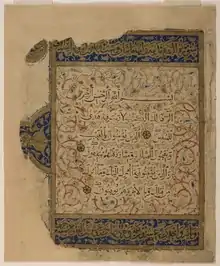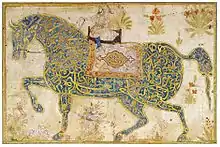2, The Cow, al-Baqarah
Al-Baqarah (Arabic: البقرة, ’al-baqarah; meaning: "The Heifer" or "The Cow") is the second and longest chapter (sūrah) of the Quran.[1] It consists of 286 verses (āyāt), 6,201 words and 25,500 letters.[2]
| البقرة Al-Baqarah The Heifer | |
|---|---|
| Classification | Medinan |
| Position | Juzʼ 1–3 |
| No. of Rukus | 40 |
| No. of verses | 286 |
| Opening muqaṭṭaʻāt | Alif lam Meem |
| Quran |
|---|
 |
|

It is a Medinan surah, that is to say that it was supposedly revealed at Medina after the Hijrah, with the exception of the verses with regard to riba (interest or usury) which Muslims believe were revealed during the Farewell Pilgrimage, the last Hajj of Muhammad.[3][4] In particular, verse 281 in this chapter is believed to be the last verse of the Quran to be revealed, on the 10th of Dhul al Hijjah 10 A.H., when Muhammad was in the course of performing his last Hajj, 80 or 90 days before he died.[5]
Surah al-Baqarah (Quran 2) enjoins fasting on the believer during the month of Ramadan.[6]
Summary
- 1-20 Unbelievers and hypocrites reproved
- 21-38 Exhortation to the worship of the true God
- 39-102 Jews and Christians urged to accept the claim of Muhammad to be a prophet of God
- 102-112 The opposition of Jews and Christians to Muhammad’s prophetic pretensions combated
- 113 The doctrine of abrogation enunciated
- 115 A Qibla declared to be unnecessary
- 116-141The Jews denounced and the religion of Abraham declared to be the true Islam
- 142-153 The Jews finally abandoned and the Arabs accepted by the adoption of Makkah as the Qibla of Islam
- 154-163 The Bereaved friends of those slain at the Battle of Badr comforted
- 164-172 Makkans exhorted to faith in God, and directed to observe the law respecting forbidden meats
- 173-176 Law concerning lawful and unlawful food (delivered at Madina)
- 177 The sum of Muslim duty
- 178-179 The law of retaliation
- 180-182 The law concerning bequests
- 183-185 The law concerning fasting
- 186-187 The fast of Ramadan
- 188-202 The pilgrimage to Makkah and war for the faith
- 203-206 Hypocrites and true believers contrasted
- 207-208 Exhortation to a hearty acceptance of Islam
- 209 The doom of infidels pronounced
- 210-212 The Jews reproached
- 213 Suffering to be patiently endured
- 214-242 Sundry laws relating to almsgiving, war, wine, lots, orphans, marriage, women, oaths, and divorce
- 243-253 The duty of warring in defence of religion enjoined by precept, and illustrated by the history of former prophets
- 254-255 256-257 The Throne Verse
- 258-260 The doctrine of the resurrection illustrated
- 261-274 Exhortation and encouragement to almsgiving
- 275-277 Usury forbidden
- 278-282, 283-284 The law concerning contracts and debts
- 285-286 The prophet’s confession and prayer [7]
Background
This is the longest chapter in the Quran and was revealed over a long period. It is a Mediniite Surah dealing with the Hypocrite (Munaafiqoon) and injunctions pertaining to various matters.
It includes many verses which have virtues like the first four and last three verses and the special Verse of the Throne (Aayatul Kursi). Muhammad is reported to have said,
“Do not turn your houses into graves. Verily, Satan does not enter the house where Surat Al-Baqarah is recited.” [Muslim, Tirmidhi, Musnad Ahmed]
Ad-Darimi also recorded that Ash-Sha`bi said that `Abdullah bin Mas`ud said, "Whoever recites ten Ayat from Surat Al-Baqarah in a night, then Satan will not enter his house that night. (These ten Ayat are) four from the beginning, Ayat Al-Kursi (255), the following two Ayat (256-257) and the last three Ayat.
Theme and subject matter
The surah addresses a wide variety of topics, including substantial amounts of law, and retells stories of Adam, Ibrahim and Musa. A major theme is guidance: urging the pagans (Al-Mushrikeen) and the Jews of Medina to embrace Islam, and warning them and the hypocrites (Munafiqun) of the fate God had visited in the past on those who failed to heed his call.[8]
The stories in this chapter are told to help the reader understand the theological conception of truth in Islam.[9]
Surah Baqarah also mentions three qualities of the God-fearing (Al-Muttaqin), that is those who possess Taqwa: 1) They believe in the unseen. Faith (Imaan) is believing and accepting something one cannot see i.e. trusting in Muhammad and the Quran. It is believing everything which is part of Imaan, the Angels, destiny etc. 2) They establish Prayer (Salah). The major sign of a person with Taqwa is they perform Prayer/Salaah. “Establishing” Salaah is fulfilling its requirements, internally with feelings in the heart, and externally fulfilling its requirements (Wudu, compulsory elements (Fard), Sunnahs, reciting with tajwid etc.) and feeling a connection with God. In a tradition or hadith, Muhammad said, “Prayer is the Mi’raaj of a Mu’min” and in Mi’raaj he spoke to God. (In the Surah preceding Surah Al Baqarah, i.e. Surah Fatiha Muslims are believed to have a dialogue with God). 3) They spend from what God has given them, as this is a form of worship too- namely, considered a financial worship. Spending in the way of God (i.e. giving Sadaqah), is to spend from what Muslims believe that God Himself gave them. Sadaqah comes from “Sidq” which means “True” as it shows the truth of a Muslim's Imaan (faith).
8-20 The hypocrites
Q2:8-20 in Surah Al Baqarah refer to the hypocrites (Munafiqun). In the Meccan phase of Muhammad, there existed two groups, the Believers and the Mushrikeen (non-believers). However, after Hijrah (Emigration to Medina) Muhammad had to deal with the opposition of those who openly accepted Islam while secretly plotting against Muslims. Their leader was Abd-Allah ibn Ubayy who was about to be crowned king before the arrival of Muhammad in Medina. The hypocrites benefitted from the Muslims while not losing their association with the disbelievers. They were considered disloyal to both parties and inclined towards those who benefited them the most in the worldly sense
The surah also sheds light on the concept of Nifaq, which is opposite of sincerity. It is of two types:
1) Nifaq in belief: outwardly showing belief however in reality there is no belief
2) Nifaq in practice: where people believe however they act like hypocrites. The signs of a hypocrite are lying, breaking promises, not keeping an amaanah or trust and when they argue they curse or use bad language.
According to a prominent scholar, Kamaluddin Ahmed, Nifaq is something that is within the heart, hence no one knows of its existence except God. Therefore, no one can be called a hypocrite or Munaafiq through one's own self-assessment. This would amount to making Takfeer i.e. calling someone a Kafir (non-believer) since Nifaq (hypocrisy) in belief is kufr.
26 Commences with ۞[10] (rubʿ al-ḥizb), an Islamic symbol.
87-105 is preserved in the Ṣan‘ā’1 lower text.[11]
- Indeed, We gave Moses the Book and sent after him successive messengers. And We gave Jesus, son of Mary, clear proofs and supported him with the holy spirit.[12] But is it [not] that every time a messenger came to you, [O Children of Israel], with what your souls did not desire, you were arrogant? And a party [of messengers] you denied and another party you killed. [Q2:87][13]
Condemnation of alcoholic beverages and gambling is also first found in the chapter,[14] and it is one of only four chapters in the Quran to refer to Christians as Nazarenes instead of the more frequent terms People of the Book or "Helpers of Christ."[15]
Al-Baqarah contains several verses dealing with the subject of warfare. Q2:190-194 are quoted on the nature of battle in Islam.
The surah includes a few Islamic rules related to varying subjects, such as: prayers, fasting, striving on the path of God, the pilgrimage to Mecca, the change of the direction of prayer (Qiblah) from Jerusalem to Mecca, marriage and divorce, commerce, debt, and a great many of the ordinances concerning interest or usury.[8]
255 "The Throne Verse"
Verse 255 is "The Throne Verse" (آية الكرسي ʾāyatu-l-kursī). It is the most famous verse of the Quran and is widely memorized and displayed in the Islamic world due to its emphatic description of God's omnipotence in Islam.
Verse 256 is one of the most quoted verses in the Quran. It famously notes that "There is no compulsion in religion". Two other verses, 285 and 286, are sometimes considered part of "The Throne Verse".[16]
282 "Verse of Loan and Women's testimony"
Verse 2:282[17] covers two specific Islamic jurisprudence issues: (1) undertaking a loan and (2) the status of women's testimony.[18]
Amin Ahsan Islahi in his Tafsir of Surah al-Baqarah says when there is a loan transaction for a specific period of time, it must be formally written down. Both the lender and the debtor must trust the writer. There must be two witnesses: two men, or one man and two women. The security of the writer must be guaranteed. The length of the contract should be stated exactly.[19][20]:2:282
al-Jalalayn says, "summon to bear witness the debt two witnesses men mature Muslim free men; or if the two witnesses be not men then one man and two women"[21][20]:2:282
See also
Notes
References
- Salwa M. S. El - Awa, Introduction to Textual Relations in Qur'an, pg. 1. Part of the Routledge Studies in the Qur'an series. London: Routledge, 2005. ISBN 9781134227471
- Ibn Kathir
- Mahmoud Ayoub, The Qurʾan and its interpreters, pg. 55. Albany: State University of New York Press, 1984. ISBN 9780791495469
- Maariful Quran
- Qurtubi
- Michael Binyon, Fighting is 'allowed' during the holy month of fasting The Times, 18 December 1998
- Wherry, Elwood Morris (1896). A Complete Index to Sale's Text, Preliminary Discourse, and Notes. London: Kegan Paul, Trench, Trubner, and Co.
 This article incorporates text from this source, which is in the public domain.
This article incorporates text from this source, which is in the public domain. - Sadr-'ameli Sayyid Abbas. "Surah Al-Baqarah, Chapter 2, Introduction". Al-islam. Retrieved 14 May 2015.
- R. G. Ghattas and Carol B. Ghattas, A Christian Guide to the Qur'an: Building Bridges in Muslim Evangelism, pg. 40. Kregel Academic, 2009. ISBN 9780825493423
- https://quran.com/2?translations=20
- Behnam Sadeghi & Mohsen Goudarzi, "Sana'a and the Origins of the Qu'ran", Der Islam, 87 (2012), 37.
- Q2:87 Clear Quran
- Sahih International
- Kathryn Kueny, The Rhetoric of Sobriety: Wine in Early Islam, pg. 66. Albany: State University of New York Press, 2001. ISBN 9780791450536
- Karen Steenbrink, "Muslims and the Christian Other: Nasara in Qur'anic Readings." Taken from Mission is a Must: Intercultural Theology and the Mission of the Church, pg. 200. Eds. Frans Jozef Servaas Wijsen and Peter J. A. Nissen. Volume 40 of Church and Theology in Context Series. Amsterdam: Rodopi, 2002. ISBN 9789042010819
- "Surah Al-Baqara Verse 256 | 2:256 البقرة - Quran O". qurano.com. Retrieved 2020-12-04.
- "Quran 2:282 Translation Yusuf Ali (Orig. 1938)". Islam Awakened. Retrieved 7 May 2020.
- "Surah Al-Baqara Verse 282 | 2:282 البقرة - Quran O". qurano.com. Retrieved 2020-12-04.
- Amīn Aḥsan Iṣlāḥī (2007). Tafsir of Surah al-Fātihan and Surah al-Baqarah. The Other Press. ISBN 978-983-9154-88-7.
- Ibn Kathir. "Tafsir Ibn Kathir (English): Surah Al Baqarah Pt II". Quran 4 U. Tafsir. Retrieved 22 December 2019.
- al-Jalalayn. "The Tasfirs". altafsir.com. Retrieved 7 May 2020.
External links
- Quran 2 Clear Quran translation
 Works related to The Holy Qur'an (Maulana Muhammad Ali)/2. The Cow at Wikisource
Works related to The Holy Qur'an (Maulana Muhammad Ali)/2. The Cow at Wikisource- "The Cow", a manuscript, dating from the 13th-century, of the al-Baqarah via the World Digital Library
- Qur'anic Verses, a manuscript for al-Baqarah from the 13th-century
